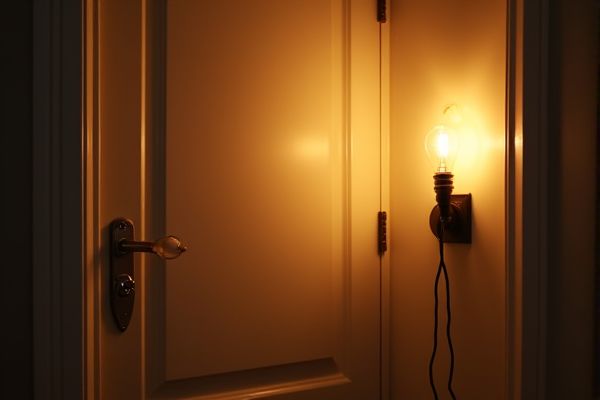
Hardwired lights offer a permanent, streamlined lighting solution connected directly to your home's electrical system, while plug-in lights provide flexibility and easy installation without the need for wiring. Discover the pros and cons of each option to determine which lighting type best suits your space and needs in the rest of this article.
Table of Comparison
| Feature | Hardwired Light | Plug-in Light |
|---|---|---|
| Installation | Requires professional wiring and mounting | Simple plug into existing outlets |
| Power Source | Direct electrical wiring | Standard electrical outlet |
| Flexibility | Fixed location, hard to relocate | Portable and easy to move |
| Cost | Higher installation cost | Lower upfront cost |
| Safety | Less risk of tripping hazards | Potential tripping due to cords |
| Aesthetics | Seamless, integrated look | Visible cords and plugs |
| Energy Efficiency | Generally more efficient with built-in controls | Depends on bulb and use |
| Maintenance | Requires electrical knowledge for repairs | Easy to replace or unplug |
Introduction to Hardwired and Plug-In Lights
Hardwired lights connect directly to a home's electrical system, offering a permanent and streamlined lighting solution ideal for ceilings and walls. Plug-in lights rely on standard electrical outlets, providing flexibility and ease of installation without electrical wiring modifications. Choosing between hardwired and plug-in lighting depends on factors such as installation complexity, desired aesthetics, and mobility.
Key Differences Between Hardwired and Plug-In Lights
Hardwired lights are directly connected to your home's electrical system, offering a seamless and permanent lighting solution that often enhances property value and provides consistent power without reliance on outlets. Plug-in lights, on the other hand, offer flexibility and ease of installation since they connect to standard electrical sockets, making them ideal for renters or temporary setups where rewiring isn't an option. Your choice depends on factors like installation complexity, mobility needs, and long-term lighting goals.
Pros and Cons of Hardwired Lighting
Hardwired lighting offers a sleek, permanent installation with seamless integration into a home's electrical system, providing consistent power and often greater control options through smart home devices. This type of lighting tends to enhance property value and reduces the risk of accidental unplugging, but requires professional installation that can be time-consuming and costly. The main drawbacks include less flexibility in repositioning fixtures and potential difficulties during renovations or repairs.
Advantages and Disadvantages of Plug-In Lighting
Plug-in lighting offers easy installation without the need for electrical wiring, making it ideal for renters or those seeking flexibility in room layout. Its main advantages include portability and quick setup, while disadvantages involve potential clutter from cords and reliance on available outlets. You can easily move or replace plug-in lights, but they might not provide the seamless aesthetic or permanent fixture quality of hardwired lighting.
Installation Requirements: Hardwired vs Plug-In
Hardwired lights require professional electrical wiring connected directly to the building's electrical system, ensuring a seamless, permanent installation often integrated with existing switches and circuits. Plug-in lights offer simple installation by plugging into standard electrical outlets, providing flexibility in placement without the need for electrical modifications or professional assistance. Choosing between the two depends on the building's wiring infrastructure, installation complexity, and long-term lighting needs.
Safety Considerations for Each Lighting Option
Hardwired lights offer enhanced safety by reducing tripping hazards and eliminating exposed cords, which decreases the risk of electrical accidents. Plug-in lights provide flexibility but require careful management of cords and outlets to prevent overloads and potential fire hazards. You should assess your space and usage needs to decide which lighting option ensures the safest environment for your home or office.
Cost Comparison: Hardwired vs Plug-In Lights
Hardwired lights generally have a higher upfront cost due to professional installation fees and electrical work, while plug-in lights offer lower initial expenses as they require no specialized labor. Over time, hardwired systems tend to be more cost-effective by eliminating the need for frequent replacements caused by cord damage or accidental unplugging, which is common with plug-in models. Energy efficiency differences are minimal, but hardwired fixtures often provide better long-term value through integrated control options and reduced maintenance costs.
Aesthetic Impact on Interior Design
Hardwired lights offer a seamless integration with ceilings and walls, creating a clean, minimalist look that enhances architectural features without visual clutter. Plug-in lights, with visible cords and outlets, provide flexibility but may disrupt interior design cohesion by drawing attention to functional elements. Choosing hardwired fixtures elevates aesthetic appeal by maintaining uninterrupted lines and consistent lighting zones in contemporary and traditional spaces.
Ideal Applications for Hardwired and Plug-In Lights
Hardwired lights are ideal for permanent lighting solutions in kitchens, hallways, and outdoor pathways where consistent, integrated illumination is essential. Plug-in lights excel in flexible applications such as temporary task lighting, renters' spaces, or areas lacking existing electrical wiring, offering easy installation and repositioning. Both types accommodate varying needs but differ significantly in installation complexity and permanence, influencing choice based on the specific application.
How to Choose the Best Lighting Option for Your Space
Hardwired lights offer a seamless, permanent solution with cleaner aesthetics and higher power capacity, ideal for rooms requiring consistent illumination or integration with smart home systems. Plug-in lights provide flexibility and ease of installation, perfect for renters or spaces where frequent repositioning is needed. Evaluate your space's power access, installation feasibility, and long-term usage to determine whether the stability of hardwiring or the convenience of plug-in lighting better suits your needs.
 homyna.com
homyna.com